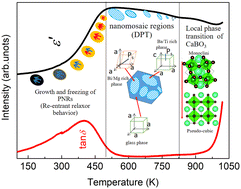Origin of the ultra-wide temperature dielectric stability and dynamic behavior of nanoregions in 0.6Bi(Mg0.5Ti0.5)O3–0.4Ba0.8Ca0.2(Ti0.875Zr0.125)O3†
Abstract
0.6Bi(Mg0.5Ti0.5)O3–0.4Ba0.8Ca0.2(Ti0.875Zr0.125)O3 (0.6BMT–0.4BCZT) ceramics exhibit an ultrahigh dielectric thermal stability. In this work, the relationship between the local structure and the physical properties of this system is revealed using in situ XRD, in situ Raman, TEM and dielectric responses. It is found that the formation and freezing of both polar nanoregions (PNRs) and nanomosaic structures (NMSs) that comprise ferroelectrically active Ba/Ti rich and weakly polar Bi (and Mg) rich phases are responsible for the high dielectric thermal stability. Three dielectric anomalies, i.e. low-temperature re-entrant dipole-glass-like relaxor behavior, mid-temperature diffuse phase transition (DPT), and high-temperature local phase transitions can be described using the phenomenological statistical model. Furthermore, the relaxor behavior follows the Vogel–Fulcher law and the new glass model. The dipole-glass-like relaxor nature of 0.6BMT–0.4BCZT was characterized by P–E loops. The beta value obtained from the isothermal electrical modulus shows three critical temperatures corresponding to the formations of PNRs, NMS and local phase transition of calcium-containing perovskites.



 Please wait while we load your content...
Please wait while we load your content...